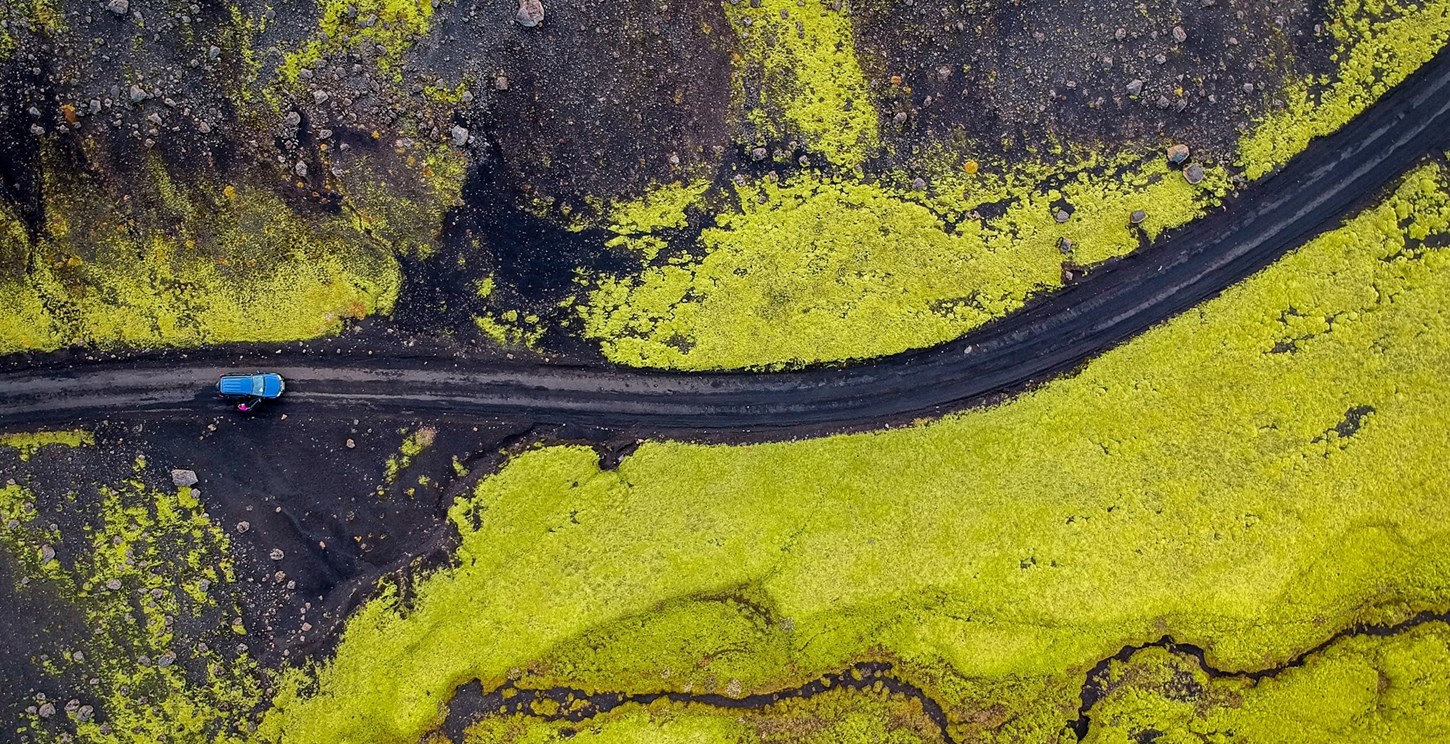How to Drive on Iceland’s F-Roads
A Guide to Iceland’s F-Roads
If you only have a few days in Iceland, making the absolute most of your limited time is your first priority. The Highlands is often a goal for the more adventurous travelers, but Iceland’s F-Roads are a mystery for many.
For those who may not be aware of Iceland’s Highland routes, the area’s network of gravel roads, known as F-Roads, is difficult to navigate, as they often contain loose gravel and unpredictable terrain. We have put together a comprehensive guide for drivers who are new to F-Road driving, as well as a trusty F-Roads of Iceland map, so that you can enjoy the scenery without putting your safety at risk.
Iceland’s F-Roads provide access to the breathtaking and remote highlands, offering an unforgettable adventure for those prepared to tackle the challenges. To navigate these rugged Icelandic Highland roads safely, it’s essential to plan ahead and drive responsibly. Here’s everything you need to know:
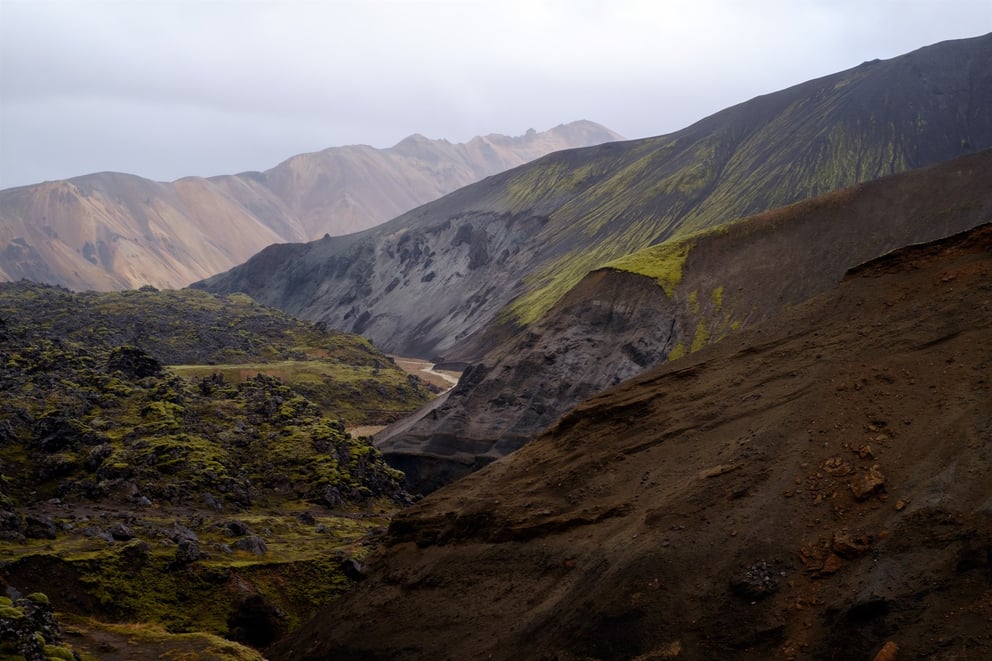
What are Iceland’s Highlands?
The Highlands of Iceland cover the majority of the inland area of the country. Situated around 400-500 meters above sea level, this volcanic desert is almost entirely devoid of human life and vegetation. The ground here is mostly volcanic ash and dirt. There are some sparse, oasis-like locations around the Highlands, but they are few and far between.
What are Iceland’s F-Roads?
F-Roads are roads that access the Highlands of Iceland. Iceland’s F-Roads are well known for taking drivers to some of the country’s most beautiful and wild locations. They are also infamous for their taxing conditions, with rough terrain and bad weather common in these more remote parts of the country. It's for this reason that we recommend doing your research or avoiding these F-Roads altogether, especially if you’re not a confident driver.
What Vehicle is Required for Traveling the F-Roads?
To take on Iceland’s F-Roads, an SUV with 4-wheel drive is essential. Iceland’s Highlands offer immense natural beauty but are untamed. The tracks can often be complicated to drive on, so it is important that you have a sturdy 4x4 vehicle to take you safely across the roads. Some of our most popular 4x4 models include:
This is mandatory by Icelandic law, so ensure you are prepared with a suitable rental car before venturing onto F-Roads. Most F-Roads will have the following road sign at the entrance to warn you of this restriction.
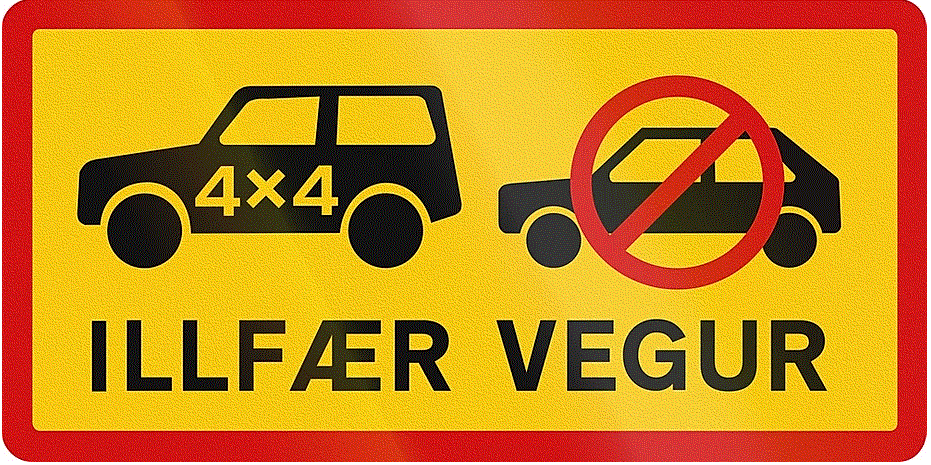
Is there a Map of Iceland’s F-Roads?
Yes! As you can see from the F-Roads of Iceland map we have shared below, there are a number of Highland routes in Iceland. The most well-known roads are:
- F35 Kjölur
- F26 Sprengisandur
- F208 Fjallabaksleið Nyrðri
It’s important to take an F-Roads map with you when you are traveling in Iceland's Highlands. You should also check conditions regularly when your mobile signal allows you to do so. If you know you are planning to travel on a variety of F-Roads throughout your trip, you can visit Road.is to find their very helpful F-Roads map. It also shows live coverage of the conditions of all the roads in Iceland. This will help you travel safely on the F-Roads and beyond.
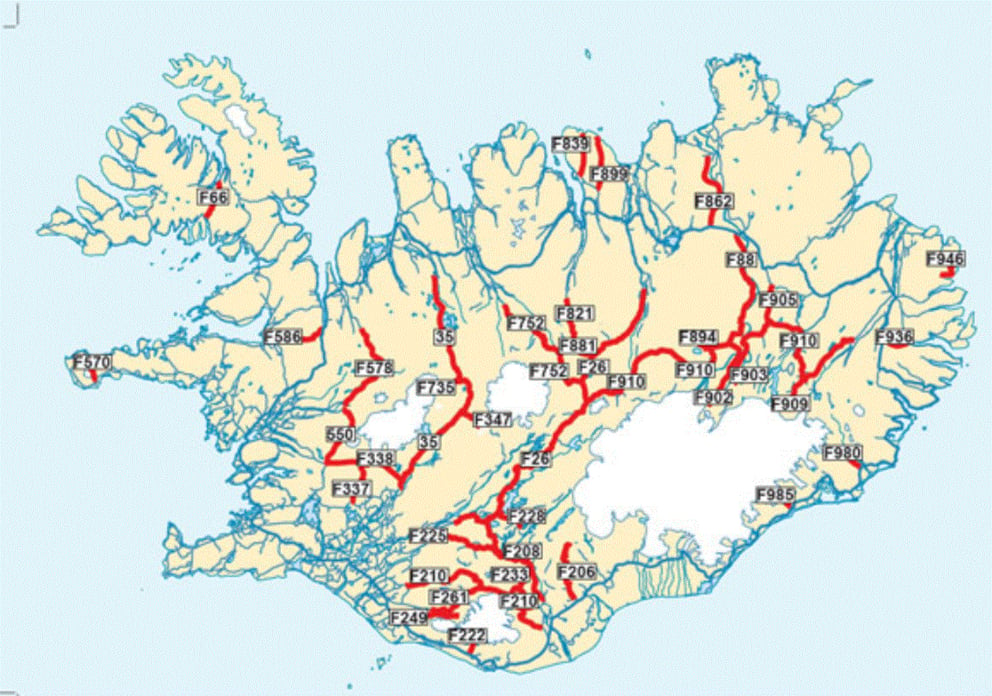
Map from Road.Is
When are Iceland’s F-Roads Open?
Due to weather conditions, F-Roads are only open for a short period of time. Most of the roads are open during the summertime, anywhere between June and September. When F-Roads are opened for the season, they are assessed for snow on the roads and the level of damage. In order to open the roads, they need to be in good condition to withstand future driving. Always check the latest travel info pertaining to Iceland’s F-Roads.
When is the Best Time to Travel the Highlands?
Due to the above, the best time to travel in the Highlands would be the summer months. It is important to keep in mind the unpredictability of the seasons in Iceland. The weather can be bad enough that some roads only officially open in late July, and winter arrives at unpredictable dates as well, leading to potentially unexpected or early closures.
What Should I Know Before Driving the F-Roads?
If you’re confident about taking on the adventure of driving on the F-Roads in Iceland, there are some things to consider before and during your time in the Highlands.
Check Beforehand: Even if you know that F-Roads are open, be sure to regularly check the Icelandic weather forecast and predicted road conditions.
Be Confident: Get to know your vehicle and ensure that you are confident enough. It is imperative that your car is a 4x4, but you will also need to know how to handle it properly. Ask the staff when you pick up your car for more information.
Limit Your Speed: It is important that you limit your speed when driving F-Roads. They can be complicated to navigate, so do not rush and take your time.
Avoid Rivers: Heavy rain can raise river levels immediately, so crossing rivers is incredibly dangerous. We suggest completely avoiding crossing high water levels. Also, you should never cross a river where the water is still, as this could be a deep area.
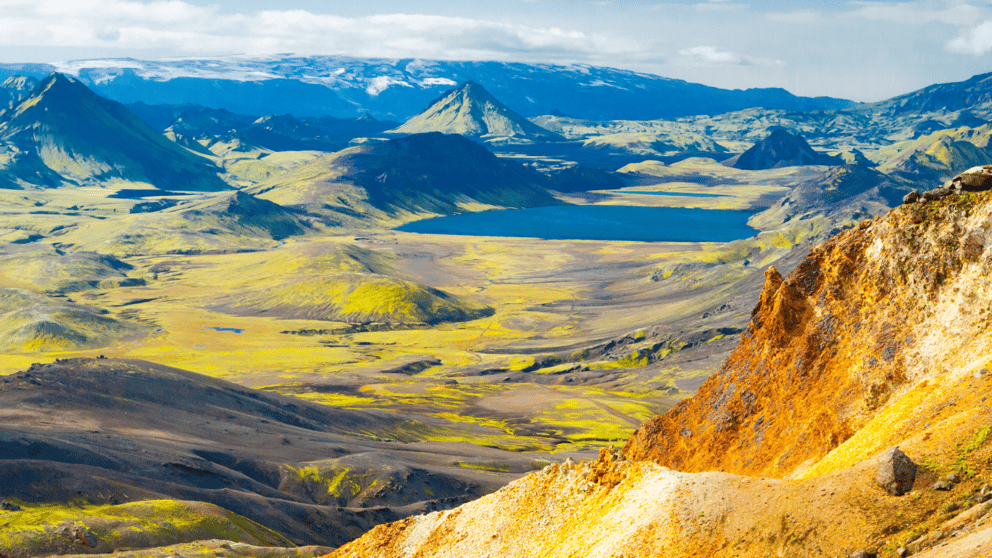
Does my Route Contain an F-Road?
Due to the confusing nature of F-Roads, many travelers tend to wonder if their route contains F-Roads. In most cases, it does not. A large number of visitors tend to stick to popular routes such as the Golden Circle, the South Coast, and Iceland’s Ring Road. These routes are easy to navigate and do not contain F-Roads. Always check your route ahead of time, and feel free to reach out to us when you collect your rental car. We can let you know if you’ll encounter any F-Roads.
What are the Most Popular F-Roads?
One of the most popular locations, only accessible via F-Roads, is Landmannalaugar. There are 3 main routes to take; F208 is by far the easiest and is accessible by most 4x4s. The second is the F225, which requires a larger 4x4, such as a Toyota RAV4. There are also F26 and F206, which are completely inaccessible unless you are in a fairly raised vehicle. Here is a list of all of the main F-Roads:
F26 – Sprengisandur/Sprengisandsleið - Hrauneyjar - Nýidalur
F26 – Sprengisandur/Sprengisandsleið - Nýidalur - Bárðardalur
F35 – Kjölur - Gullfoss - Hveravellir
F35 – Kjölur - Hveravellir - Blonduvirkjun
F88 – Öskjuvegur - To Herdubreidarlindir
F88 – Öskjuvegur - To Herdubreidarlindir
F225 – Landmannaleið
F550 - Kaldidalur
Are F-Roads Worth It? What Can I See?
Iceland has a surprise in store around every corner, and this is especially true in the more remote areas of the country. There are many beautiful locations to see in the Highlands, and chances are you will be one of the few people there. In fact, many places you visit in the Highlands will be empty of any other tourists at all! The Highlands are home to the best-kept secrets of the country, and F-Roads are often the best way to explore these to your heart’s content.
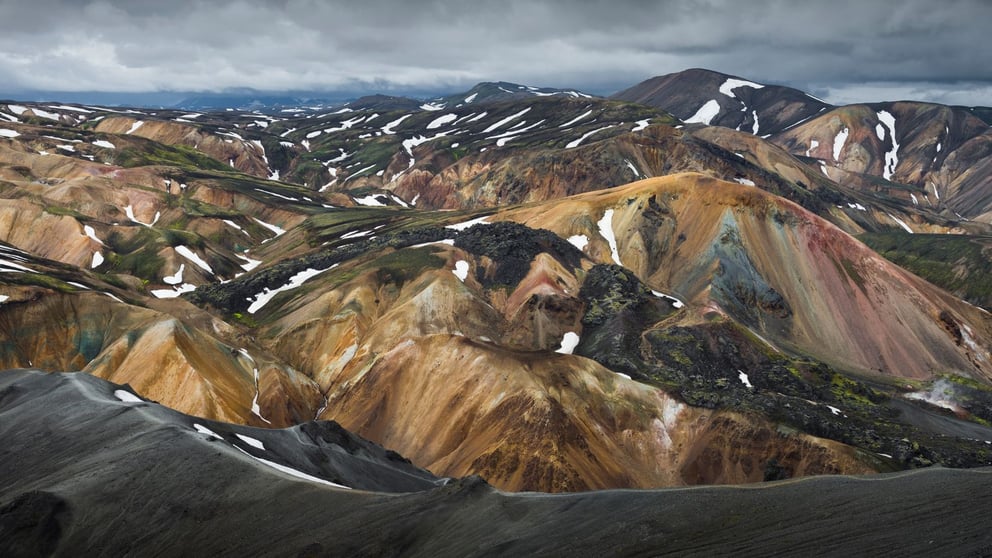
Landmannalaugar is famous for its colorful, picturesque landscape and geothermal pool, which is a popular tourist attraction. The pool and surrounding area are easily accessible from Reykjavik for a day trip. Askja is the caldera of a volcano in Iceland, which last erupted in 1875, leaving behind a striking deep blue lake. Close by is the Víti crater, which is a popular geothermal bath among bathing enthusiasts, although it can get quite hot.
Other attractions in Iceland’s Highlands include:
Hekla Volcano: A hiker’s paradise and one of the most active volcanoes in the world.
Þórsmörk: Home to mind-blowing scenery and mountain ridges, as well as an iconic Icelandic trekking route.
Langisjór Lake: Views over this huge natural lake are the cherry on top of any hike!
Preparation Checklist
Exploring F-Roads in Iceland requires careful preparation:
Choose a suitable vehicle: Only 4x4 vehicles are permitted on Iceland’s F-Roads, as the rugged terrain demands extra power and ground clearance.
Inform someone of your plans: Share your itinerary with a friend, family member, or local contact so someone knows your whereabouts.
Bring a detailed map: A physical F-Roads Iceland map is essential as mobile GPS can be unreliable in the highlands.
Check road conditions: Visit road.is for real-time updates on Iceland highland roads, including closures or hazards.
What Driving Tips Should I Be Aware of in the Highlands?
Driving Tips
Navigating the challenging terrain of Iceland’s F-Roads requires caution and attention:
Travel in groups if possible: Driving in tandem with another vehicle is safer in case of emergencies.
Drive carefully: Gravel roads can be slippery, and wet conditions can make certain areas unstable. Keep your speed low and remain vigilant.
Approach river crossings with care: Many F-Roads in Iceland require crossing rivers, which can be hazardous. Assess the depth and flow before crossing, and avoid taking risks.
Emergency Preparedness
Mobile signal is often limited on Iceland’s Highland roads, so it’s vital to be prepared for emergencies. Remember that Iceland’s emergency number, 112, can be dialed even without a mobile connection.
Fuel Availability
Fuel stations are scarce in the Highlands, with only one located at Hveravellir. Be sure to refuel before heading onto remote Iceland F-Roads to avoid being stranded.
Protecting the Environment
Off-road driving in Iceland is strictly prohibited to protect the fragile ecosystem. Always stay on marked trails and designated roads to ensure the safety of the environment and yourself.
By following these tips, you can confidently navigate Iceland’s stunning Highland roads and enjoy an unforgettable journey through the heart of the country’s rugged landscapes.
All that’s left now is to book your 4x4 with Iceland Car Rental and start your adventure. Explore Iceland car rental your way.

